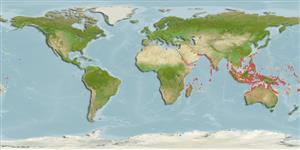Environment: milieu / climate zone / depth range / distribution range
البيئة
بحري مرتبطة بالشعاب; نطاق العمق 1 - 20 m (Ref. 9710). Tropical; 31°N - 25°S, 32°E - 169°W (Ref. 5222)
Indo-Pacific: Red Sea to the Phoenix Islands and Samoa, north to Ryukyu Islands, south to Australia.
Length at first maturity / الحجم / وزن / العمر
Maturity: Lm 36.6, range 30 - ? cm
Max length : 80.0 cm TL ذكر/ مختلط الجنس; (Ref. 90102)
الأشواك الظهرية (المجموع): 7 - 8; الأشعة الظهرية الناعمة (المجموع): 10-12; شوكة شرجية 3; أشعه شرجية لينه: 8. This species is distinguished by the following characters: body elongate and robust, depth 2.9-3.9 in SL; preopercle broadly rounded, with 3 large, ventrally-directed spines along lower half; opercle with 3 flat spines, the upper and lower spines covered by skin; nostrils subequal, set in a shallow groove running forward from eye; large canine teeth at front of jaws; 1-4 large canines on side of lower jaw; gill rakers of first gill arch 0-2 + 2-7; caudal fin truncate to slightly emarginate, the caudal concavity more than 13 times in HL; pectoral-fin rays 15-16, 2.0-2.3 in HL; lateral-line scales 83-97. Colour whitish to pale grey color, with numerous round to oval dark-edged blue spots (the largest about equal to pupil); most spots within a spot diameter of adjacent spots; head, body, and median fins frequently with 4-5 dark blotches forming saddles on back (greenish grey); pelvic fins with dark brown to blackish membranes; rear margin of caudal fin with a white edge and often with a blackish submarginal band (Ref. 39231, 89707, 90102).
Adults inhabit lagoon and seaward reefs, in areas with rich coral growth. Most frequently encountered in channels along the reef front (Ref. 9710, 48635). Often a shy fish (Ref. 48635). Feed exclusively on fishes (Ref. 37816). Misidentified as P. leopardus in Ref. 2928 (Johannes, pers. comm.). This study reports of a declining stock in Palau due to fishing. Before actual spawning around full moon, the species aggregates along channels and are responsive to baited hooks, making them vulnerable to fishermen; upward movements of some to take baited hooks presumably mistaken for courtship or spawning behavior. Large individuals may be ciguatoxic in certain areas (Ref. 37816). In the Hong Kong live fish markets (Ref. 27253). Of interest to artisanal fisheries and caught with hook-and-line (Ref. 39231).
Life cycle and mating behavior
النضج | التكاثر | وضع البيض | بيض | الخصوبة | Larvae
Heemstra, P.C. and J.E. Randall, 1993. FAO Species Catalogue. Vol. 16. Groupers of the world (family Serranidae, subfamily Epinephelinae). An annotated and illustrated catalogue of the grouper, rockcod, hind, coral grouper and lyretail species known to date. Rome: FAO. FAO Fish. Synop. 125(16):382 p. (Ref. 5222)
IUCN Red List Status (Ref. 130435)
خطر للأنسان
Reports of ciguatera poisoning (Ref. 4690)
استخدامات بشرية
مصائد: غير مهمة تجارياً
مزيد من المعلومات
مراجعالأستزراع المائيملف الأستزراع المائيسلالاتجينيElectrophoresesالتوريثالأمراضمعالجةNutrientsMass conversion
المتعاونينصورStamps, Coins Misc.اصواتالتسمم باكل السمكسرعةنوع السباحةمنطقة الخياشيمعظمة الأذندماغرؤية
أدوات
تقارير خاصة
Download XML
مصادر علي الأنترنت
Estimates based on models
Preferred temperature (Ref.
123201): 26.4 - 29.3, mean 28.5 °C (based on 1868 cells).
Phylogenetic diversity index (Ref.
82804): PD
50 = 0.5078 [Uniqueness, from 0.5 = low to 2.0 = high].
Bayesian length-weight: a=0.01148 (0.00558 - 0.02364), b=3.04 (2.88 - 3.20), in cm total length, based on LWR estimates for this (Sub)family-body shape (Ref.
93245).
مستوى غذائي (Ref.
69278): 4.5 ±0.80 se; based on food items.
المرونه (Ref.
120179): وسيط, الحد الزمني الأدني لتضاعف عدد أفراد المجتمع 1.4-4.4 سنة (tm=2.5; Tmax=14;).
Fishing Vulnerability (Ref.
59153): Moderate vulnerability (36 of 100).
Climate Vulnerability (Ref.
125649): Very high vulnerability (88 of 100).
Nutrients (Ref.
124155): Calcium = 35.7 [20.3, 68.5] mg/100g; Iron = 0.617 [0.317, 1.074] mg/100g; Protein = 19.1 [17.2, 20.8] %; Omega3 = 0.135 [0.085, 0.221] g/100g; Selenium = 33.9 [18.5, 66.7] μg/100g; VitaminA = 73.1 [25.6, 238.9] μg/100g; Zinc = 0.729 [0.483, 1.107] mg/100g (wet weight);
